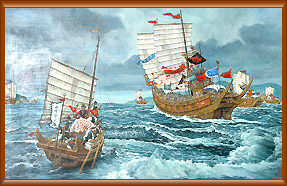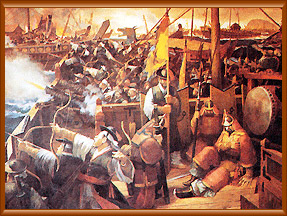Counterattack of Joseon-Ming United Forces and End of War
With the urgency of situation in Joseon, the Ming Dynasty dispatched the rescue forces. Yangho stayed in Pyeongyang and Magui came to Seoul first and divided the generals in June to protect the applicable regions.
Thereafter, the Japanese forces began to march toward north from July 28 and take Ukida as the commander with 50,000 troops to leave Sacheon to pass Hadong to come into Gueye, and some went through Hamyang to come into Wunbong and attacked Namwon. Also, with Mori as the commander, 50,000 troops went through Chogye and Anui to march toward Jeonju, and a part would detoured Seongju to march toward the Anui and Jeonju direction. At that time, the Joseon-Ming United Forces was stationed in Namwon, but was defeated by the Japanese forces that was commenced from August 14. Also, Yugyeok Jin Woo-chung of Ming Dynasty who was defending Jeonju with 2,000 troops was defeated and the Japanese forces took Jeonju without having the shed blood.
As such, the Japanese forces kept on marching, Ming Dynasty used the retreated troops from the south to keep Seoul in Han River and Gyeongri Yangho in Pyeongyang came to Seoul to command the stoppage of Japanese forces from invading further north. Thereafter, Yangho had Buchongbyeong Haesaeng, Woo Baek-young, and others to advance to the south, and on September 5, it collided with the Kuroda Command at Sosapyeong of northern Jiksan to defeat to completely stop the Japanese forces from marching north.
Along with that, Yi sun-shin, as he was appointed as the Commander of Three-province Navy again, had a great victory against the main fleet of the Japanese forces at the Myeongryang Strait on September 16 to seal off the Japanese forces from advancing into the western sea. Japanese forces cut off its routes began to gather in the southern coastal area from October for it had winter coming. Therefore, over 100,000 Japanese troops built the fortress for some 800 ris from Ulsan to Suncheon and stationed there. They had Gato and Nabeshima units stationing in Ulsan, Ukida and Mori units in Yangsan, Simazu unit in Sacheon, and Dachinaba and others in Namhae and Gonisi Unit in Suncheon.
 The battle in Myeongryang
The battle in Myeongryang
In the meantime, on August 18, 1597, Toyotomi Hideyoshi died of illness that the Japanese forces hid the death of Toyotomi and attempted to withdraw. the Admiral Yu Jeong of Ming Dynasty was reported that Gonisi Unit of Suncheon was to be retreated in mid-September and attacked them on land from September 20 and Yi sun-shin and Jin Lin sealed off the sea and had the fierce battled with the Japanese forces for several days.
Shimazu who had the request of Gonisi whose withdrawal line cut off brought some 500 ships to attach Noryang in dark evening of November 18. Yi sun-shin swore to the sky with the incense to fight against the enemy with the fleet in Noryang and destroyed about a half of enemy ships. The enemy could not sustain the attack and fell into Gwaneumpo of Namhae, but they had to come back out, and Yi sun-shin personally went into the battle ground but was shot by the enemy and killed. With his will, Yi sun-shin's nephew Yi Wan took over the command to destroy some 200 battle ships and defeated the Japanese forces. Simazu and others barely escaped the area with some 50 ships and Gonisi also barely escaped to Myo-do while fighting, and Yujeong returned to Yujeong and Jin Lin back to Namhae.
 The battle in Noryang
The battle in Noryang
After Toyotomi died and the internal politics of Japan shaky the Japanese forces had to be retreated in a hurry and it was known only after some time later. Therefore, the Imjin War for seven years finally ended.